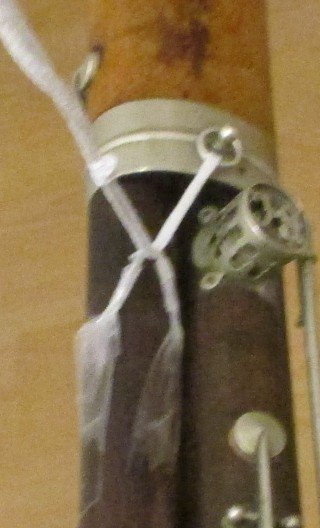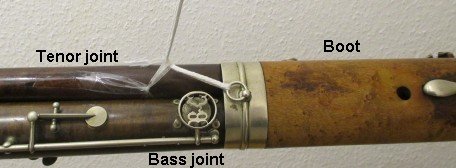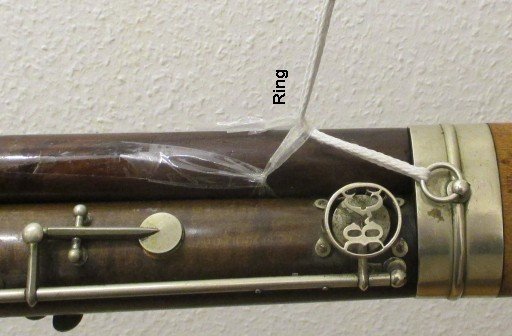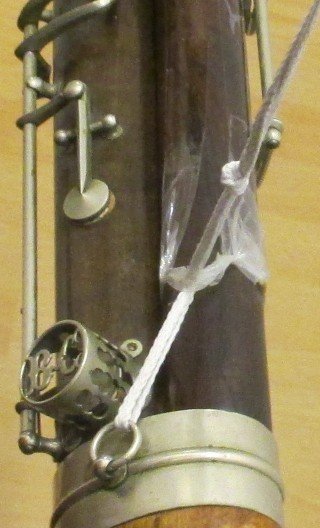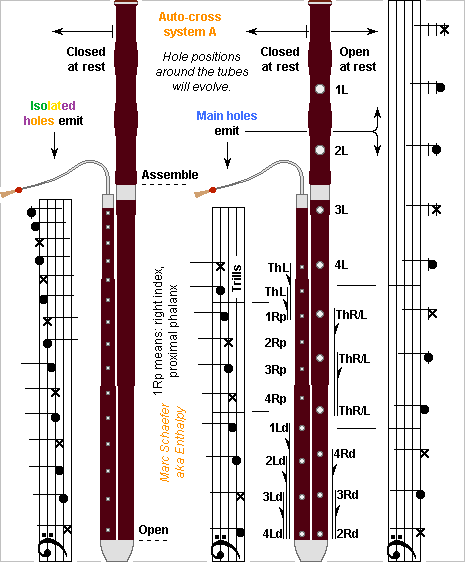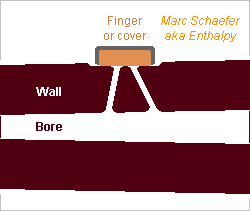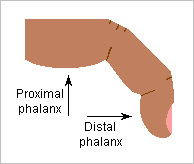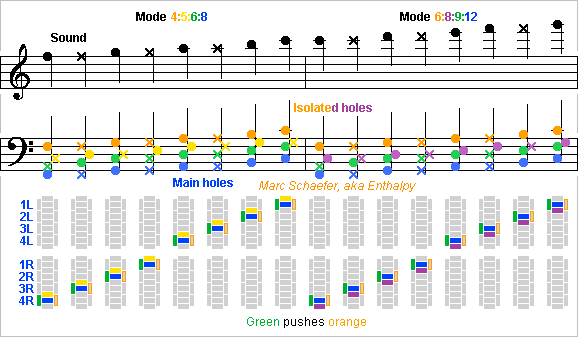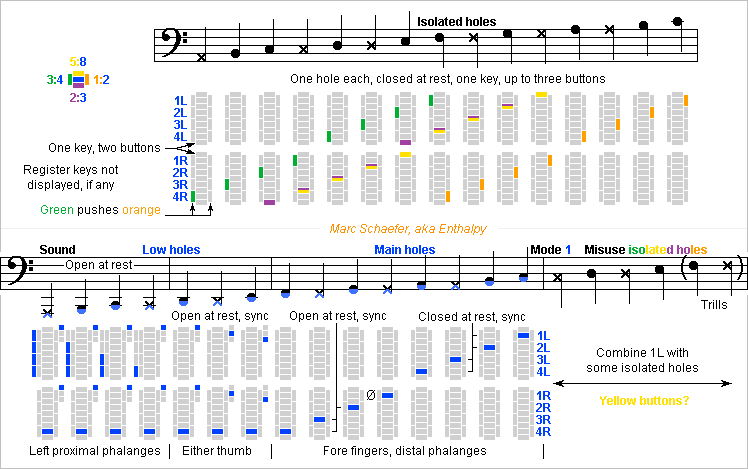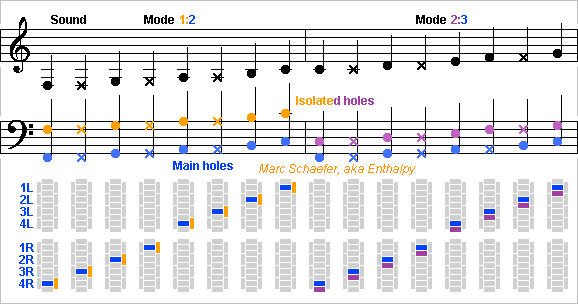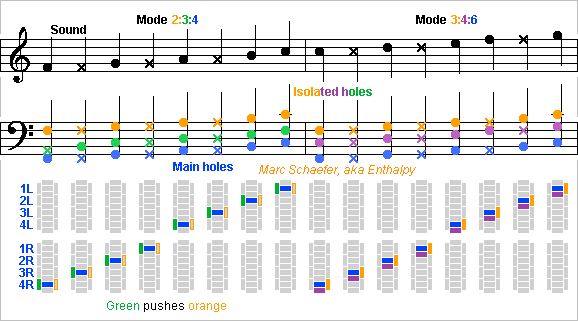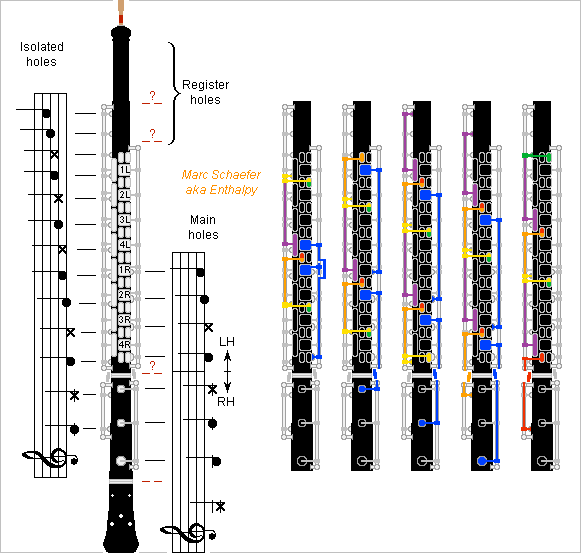-
Posts
3887 -
Joined
-
Last visited
-
Days Won
1
Content Type
Profiles
Forums
Events
Everything posted by Enthalpy
-
Zerodur claims 10-8/K too, allegedly over a wider temperature range. I guess the choice depends on where you live. Screws are the wrong choice with hard and brittle materials, sure. Other solutions. And I spent quite some time observing the Gridiron pendulum at my grand-mother's clock. But for 2D stability, or when you need zero expansion at varied positions, it gets complicated. I just wonder if the Gridiron pendulum (1726) inspired achromatic optics (known in 1750) or the other way round, or if both inventions were independent.
-

Surface tension / atmospheric pressure formulas?
Enthalpy replied to Endy0816's topic in Engineering
The books I've seen made the simple calculation. Problem, I have seen no experiment report telling "the books were right", and unfortunately it often happens that authors put some model or theory and imagine that Nature has to follow it. That is, if T is the liquid's tension and h the local height along a drop at the outlet, T*(d2h/dx2+d2h/dy2) gives you the maximum pressure difference, and it relates to the drop's radius. But I expect that the hole's material matters too, at least by restricting the angle of the drop where it exits the hole, hence the possible drop's radius. The shape beyond the hole must matter too, and definitely how far the exit is wetted. If a big area beyond the exit is wetted, the hole has no effect - which suggests the process isn't reliable or demands a special shape. Frankly, if this question has any sort of consequence, I'd search for experimental data or make measurements by myself. -
Hello fellow bassoon players! (Plural just in case) Shoulder straps or harnesses carry bassoons at the boot, or the joints might separate. This is much below the centre of gravity. An extendable part can fasten the strap higher on German bassoons, French ones typically lack it. Also, the holding point is always between both bores, supposedly because wood is thicker there, but when playing the tenor joint is almost above the bass joint, so the bassoonist must roll the instrument manually. Here's my makeshift solution to carry comfortably a bassoon, in this case a French system. It's comfortable and can inspire a durable elegant design. The strap still pulls at the boot so the joints won't separate. But it (or some textile prolongation) makes a detour at a part attached to the tenor joint permanently. The strap pulls nearer to the centre of gravity, and more at right side. With proper adjustment, the left hand must pull a bit but no roll effort is needed, very nice. My part is a ring that surrounds the tenor joint. Then it must be thin: it's few turns of adhesive tape in my embodiment. More adhesive tape holds the ring up and right in adjusted position. It takes several plies or a thicker tape; ruptures made no damage. My textile prolongation is a brand new shoe string. No, it's not Mali here, but a marketable version should improve few details. The tenor joint has thick wood where the long side holes converge to the hand, at a place that can hold the part. Maybe the part must be open or openable to introduce the strap easily. Marc Schaefer, aka Enthalpy
-
Erratum: on the last drawing of Dec 30, 2019, the four buttons for the lowest notes should be on the other side. ========== I could keep the nice bassoon's aspect with the system A automatic cross-fingerings. The hands' position are kept too. No tenor and bass joints separable from a boot here; instead, the narrow and wide joints can be of separate raw material but are kept together for transport. To clean the bore, the U-turn is removable, of usual or modified design scienceforums and next Undisplayed parts link the narrow and wide joints. They must be very stiff, collectively in all directions. Their shape change the instrument's aspect, for instance to resemble a Heckel system. Already the cover for the U-turn does much. The linking parts could carry many keys. The hole positions are approximative, both along the air column and around the tubes, which will depend on the difficult keyworks' design. All synchronised covers symbolised with arrows (for instance, opening C with 1Ld opens B, Bb and A too) sit next to an other on one same joint scienceforums Isolated holes use to sit close to a pressure node on all instruments. As opposed, throat tone holes are very inductive and sit one to three semitones higher than the pressure node on my French bassoon. Timbre demands it on a double reed. Whether the main transition gives the natural series of harmonics then? On my bassoon it does for some notes, for others not. Is it desireable? Maybe. In case a mode is a semitone higher than the natural series, reorganised buttons can play it. I only doubt that all notes in a mode shift by the same amount, and that all modes land on tuned notes then. Bassoons have no identifiable barrel in their bocal, maybe it would help. Adjustments there, and as usual downstream, tune the higher modes. The positions of the isolated holes influence the height too, but pulling too much degrades the emission and muffles the sound. My sketch suggests six main holes at the throat for the high first mode, rather than misusing isolated holes with bad compromises. The right proximal phalanges shall operate them, plus the thumb for trills, unless mode 2 can start lower for trills. If the sound gets shrill with many open isolated holes at high modes, consider split isolated holes scienceforums They can serve for the throat main holes too. The aspect of the keys might come. Some day and maybe. Marc Schaefer, aka Enthalpy
-
A woodwind can need stronger losses at some notes or high overtones. Throat notes are an example, where the short air column and its small losses let a reed vibrate too strongly, deforming the sound like a saturated amplifier does. The oboe, clarinet, tárogató have smaller tone holes at the throat to increase the losses there and also to filter out the high harmonics. The saxophone keeps wider tone holes and its timbre changes stepwise at the octave jump. The bassoon, whose tone holes cover two octaves, has very long and narrow tone holes at the throat. Cross-fingerings to play high modes can also harden the sound. On a double reed, small tone holes soften the sound at low modes, but multiple open holes for high modes that keep all harmonics tuned don't remove the strident highest ones, and their losses can be too small for the reed. The bassoon uses detuned cross-fingerings to soften the sound. Finally, woodwinds should dampen the strident partials around 4kHz scienceforums and two previous messages I propose now to split some side holes in two or more. Several narrower holes of same length and total section increase the friction at the bigger surface. Split holes can open the air column at several slightly different locations. This damps more strongly higher frequencies where the air circulates among the holes and acts well before the sum or difference of the lengths is lambda/2. Split holes can combine with the previously explained chambers. A shared chamber would act on many notes in a complicated way. ========== Split holes apply to main tone holes. Maybe Johann Heckel did it at right thumb F-emitting hole for his bassoon, but I have none to observe. The higher hole would usefully be narrower or longer. If an instrument has special holes for cross fingerings mainly, as many systems I describe do, split holes apply to them as well. Split holes might apply to register holes too. They could sit side-by-side, some slightly higher or lower optionally. Sitting at the same height, they spoil as efficiently the unwanted modes with a smaller total section that detunes less the extreme notes. Numbers might follow or not. They are only weak guidelines anyway, and experiments decide at the end. Marc Schaefer, aka Enthalpy
-
Hello everybody! The concert or pedal harp is too rare. But what about the chromatic harp then? The concert harp is diatonic, with pedals to change the key. Pretty much inadequate for romantic and posterior music, and many scores are clumsy or impossible. While smaller chromatic harps were known, in 1894 Gustave Lyon invented a large concert chromatic harp at Pleyel. Alas, the new instrument couldn't play the existing scores with diatonic glissandi, it demanded new skills too, and didn't succeed. The big instruments are survivors built by Pleyel up to 1930. One is in Brussel's fabulous Musée des Intruments de Musique, a handful are played. We can say: rare. en.wiki - fr.wiki - de.wiki (contents differs) scholarlyrepository.miami.edu link to 10MB PhD thesis there fr.wiki alleges that the last professor, Francette Bartholomée, retired in 2005, but Paola Chatelle teaches the harp in Brussels and plays the chromatic harp, and Vanessa Gerkens too teaches the chromatic harp in Belgium. The older triple-raw chromatic harp is well alive in Wales I_ImURf8KUE from 19:12 to 26:55 while the crossed chromatic instrument gets rare in Spain I_ImURf8KUE from 27:64 to 30:26 the whole Bbc documentary is fascinating. The big Pleyel instruments sound a bit dry and narrow to my ears. Maybe pedal harps sounded that way too and got a wider body meanwhile. Also, the additional strings knowingly demand a stronger table, heavier and stiffer, and the eccentric implantation lets the strings feel a stronger resistance. More recent harps, also cross-strung with 7+5 strings per octave for natural notes and accidentals. They are smaller up to now, like 5 octaves instead of 7, and sound even dryer. What's the string material? Recent small harps with 6+6 strings per octave regularly spaced. These too sound dry. Their proponents give playing arguments for the 6+6 against the 7+5. My impression (I don't play any harp!): the 6+6 instrument hasn't still developed the mean virtuosity of the 7+5 but is played by a wider group: Website - Forum Recent small harps with 12 strings per octave in one row. Doesn't exist yet: I proposed tables parallel to the strings for loudness scienceforums ========== To promote the instrument, Pleyel commissioned Debussy the Danse sacrée et danse profane for chromatic harp and orchestra. These pieces are presently played on the pedal harp, reportedly with difficult pedal movements. Here Francette Bartholomée plays them Danse sacrée - Danse profane I suppose she plays on the chromatic instrument, because I don't hear the usual parasitic noises and unnecessary caesurae, for instance at 1:15 and 3:27 in the Danse sacrée. To my ears it's nicer. Still by Francette Bartholomée on the grand Pleyel chromatic harp, pieces with quickly varying key signature if any - I have no idea how difficult they would be on a pedal harp Ballade sur un vieux Noël wallon oublié, composed by Joseph Jongen Nocturne 2 - Nocturne 3 - Pastorale, composed by Pierre Bartholomée These same pieces would sound abstruse and aggressive on a violin. Composers should write more often for the harp. Paola Chatelle learned from Francette Bartholomée, she plays on a grand Pleyel chromatic harp here jPFU88Xbpt0 composed by Auguste de Boeck 8erLhcxsSRM - 5l60HrCxkFA composed by J.S.Bach her website paolachatelle.be contains hearing samples http://paolachatelle.be/shop.html and more information. Vanessa Gerkens too learned from Francette Bartholomée, playing here a grand Pleyel chromatic harp L'écume des âmes - Avalon - La Phoenix, own compositions She has a website too http://harponomie.be with infomation about the instrument harponomie.be/...renaissance She wants new instruments to reproduce the Pleyel model. Marc Brulé already makes a 5 octaves one. Here you can compare with an excellent pedal harp. The sound is deeper Salvi factory tour different manufacturer, different age, wider body - and fewer strings located at the table's centre. Mirjam Rietberg plays a 6+6 chromatic harp made by Zangerle J.S.Bach - Debussy - Dowland (Around 1600!) Her website mirjamharp.com and her Youtube channel mirjamrietbergharp Émilie Chevillard plays jazz on a single-row chromatic harp, here in the group Colunia jazz gk2pqW2tIqg - tjDf9COt4Es solo at 5:12 a chromatic instrument seems the obvious choice for jazz, but others play the pedal instrument.
-
Hi JC, thanks for your interest! Zerodur is several magnitudes better than Invar and quite better than silica, that's why telescope mirrors prefer it. Not every instruments needs this stability, but some do, and for them Zerodur could be an advantage. Thermostat, yes. Sometimes it's not a complete solution, for instance if the instrument produces heat or if operators can touch.
-
Ahum. The boot of my French bassoon is completely different, and for the drawing of Jan 04, 2020 03:58 PM I looked at an old instrument that is NOT the usual U-bend of present bassoons. Yamaha (Fox resembles much) and Heckel page 3/12 These constructions use very little air column length. Not an advantage of my proposal. About the stiffness: The gasket, often cork, brings little stiffness. The screws are stiff but they hold at one end in wood whose shear isn't quite stiff. The other end holds on a metal plate whose bending stiffness decides. Said plate looks thick. Depending on exact figures, which I won't infer from small pictures, the standard design may or not be already stiff enough. As a small variation of the standard design, two elastomer O-rings could replace the cork gasket, especially if retained. Then, a shape that presses the metal tube directly against the wood at the bores, or rather against metal glued on the wood, would gain stiffness if needed. Electroforming would make the intricate shape at once, as already said, but the plate shall not be too thin. Marc Schaefer, aka Enthalpy
-
Hello you all! Magnetorquers serve to control the orientation of smaller satellites in low-Earth orbit. A set of big air coils, or small coils on soft magnetic rods, create a torque in the geomagnetic field. I propose instead to use an aggregate of magnetic materials and tilt it versus the geomagnetic field when wanting a torque. One aggegate serves for all directions, gaining mass over fixed rods with varied orientations. Creating a field but stronger than Earth's one suffices to orient the permanent magnet, and this takes far less power than usual magnetorquers. A big Leo satellite can be 6m*3m*3m and 15t with 56*103kg*m2 inertia. If willing to suppress 1turn/mn=0.1rad/s rotation in one day, it needs mean 65mN*m, I take peak 0.13N*m. 4.5µPa radiation pressure on a single deployed solar array, 3m*15m at 10m, makes 2mN*m only. This torque resembles more the drag on very low orbits, or radiation pressure on a small space station. The aggregate can comprise a rod of FeCo: Vacoflux 48 offers 2.35T for 8120kg/m3, 6% better than pure Fe Vacofer S1, far better than permanent magnets. 1.7dm3 create the 0.13N*m in 40µT geomagnetic field, the L=0.5m R=0.033m rod weighs 14kg and consumes 0.5kA. The ends spread to R=0.08m for 0.40T, adding some 2.2kg per end. Modelled as hemispherical, the emission of 8.0mWb from R=0.08m takes 12.7kA per end. At 0.4T and 0.88MA/m, 15mm thick Neorec53b NdFeB magnets provide the 13kA and weigh 2.3kg per end. The aggregate weighs 23kg. The huge magnets are badly dangerous. Spreading the flux more, possibly beyond the magnets, would improve. Many thin parallel FeCo rods would also reduce the leaks. A three-stage Cardan lets the aggregate rotate freely. Balls in a cage between two spherical shells can be more robust. Or levitate magnetically, using the field spread at the ends. Air coils that create 0.3mT or 5* the geomagnetic field, orient the aggregate. The depicted spherical coils are more efficient, but Helmholtz coils ease the assembly and with R=0.35m they consume 0.12kA*turn. 2*2kg aluminum windings have 0.18mohm/turn2 each and they consume 5W. Four coil planes would give redundancy, their orientation can be perpendicular to C-H in methane: (+1 +1 +1), (+1 -1 -1), (-1 +1 -1) and (-1 -1 +1). Six planes can be regularly spaced too as (1 1 0) etc. ========== Could bare air coils compete? 0.13N*m and 40µT need 3.2kA*m2. Coils 3m*3m big take 0.36kA*turn. With 3*17kg aluminum, the resistance is 0.6mohm/turn2 and they consume 81W. The advantage of a rotated aggregate improves for stronger torques. Static rods need more rods hence are heavier. ========== A static magnet, without ferromagnetic rod hence heavier than needed, oriented the nacelle of my stratospheric balloon, so more uses exist. Marc Schaefer, aka Enthalpy
-
Academic research knows already about the reed susceptance. For instance there, page 35 (pdf 45/186) Timo Grothe, Experimental Investigation of Bassoon Acoustics who cites several sources Nederveen, C. J. (1998). Acoustical Aspects of Woodwind Instruments Krüger, W. (1992). Untersuchungen am Fagott Fellner, K. (2005). Transmission-Line Simulation meines Fagotts What I strongly disagree on: there can't be one single volume equivalent to the reed. It varies a lot with the lips' pressure, which the musician uses to match and sometimes select a reonance mode, and to adjust the intonation. As the musician presses the half-reeds together (or the single reed against the mouthpiece), less area stays mobile, and with more stiffness, which reduces much the equivalent volume.
-
The air column of some woodwinds makes a U-turn: at the bassoon family, the low clarinets, past and maybe future low oboes... The ones I saw are of metal that fits over corks at tenons at the wooden body (the saxophone differs). This must dampen the sound, like cover pads do, because the metal tube is light and the cork soft. I suggest to fit the metal U-turn in the wooden or polymer body with a metal lining, like Yamaha do for their wooden flutes scienceforums - scienceforums europe.yamaha.com The stiff contact between metals should improve more here than between straight heavy wooden flute joints. Very useful too, these fittings are short, so tone holes can have better locations. The metal parts can be electroformed as already suggested scienceforums and followers They probably need adjustment, as for flutes and brass instruments. Wood expands much with moisture and heat, flutes' Dalbergia less, bassoons' Acer more so, while metal expands little. Yamaha flutes cope with that. The metal lining could fit narrowly in the wood at one end and fit narrowly over the metal tenon at the other, possibly with some elastomer there. Or fit the wood at both ends and the tenon at midlength. Wooden joint have reinforcing hoops at their ends, of metal often, of graphite fibres on some clarinets. An adjusted amount of fibres would let the wood fit the metal's thermal expansion. Present bassoons have both bores in a single wooden part. A global hoop of graphite fibres would stabilize the bore spacing. Trumpets can cope with some spacing mismatch. If separate wooden parts make both bores, metal parts can assemble them. Pyramids would stiffen all directions scienceforums - scienceforums Whether the bell of a bass clarinet can hold at such a fitting? I'd rather put the U-turn higher, and some toneholes on a rising wooden joint, especially for clarinets reaching a written C as they're uncomfortably long. Marc Schaefer, aka Enthalpy
-
Here's the flute head stopper I made around 1992 and have been using since. It needs only to turn and bore one part. Mine happens to be Ptfe. The O-rings are banal, maybe Nbr. The metal rod moves the stopper when inserted in the hole. I noticed no difference with the usual stopper, but a decent flute might let perceive one. Marc Schaefer, aka Enthalpy
-
-
Here's a basson with quasi-automatic cross fingerings system A, loosely inspired by the soprito system F of Dec 15 and 22, 2019 scienceforums and next one On mode 2 and higher, the musician presses one finger at a time, like on a piano to play a single note. The finger's main button closes all main holes above the main transition and opens them all below. By pressing nearby buttons too, the same finger opens isolated holes to easily make the equivalent of cross-fingerings. Bassoons span some two octaves with tone holes, what other instruments can't, and their high holes stabilize the high register. Their lowest 7 holes don't serve for mode 2 but the next ones can be closed even on very high notes. I mimicked that on the quasi-automatic system. Assembling a tenor and a bass joint to a boot would be unreasonable here. The tenor and bass joint hold permanently together and extend to the short removable U-turn. The longer bell has two tone holes. This makes a case as long as for a tenor saxophone, thinner and lighter. Long parts of Liquid Crystal Polymer (LCP) or polyketone are easy, of polypropylene and sycamore too, while Dalbergia is problematic for other reasons. The 4 lowest holes are open at rest. The left fore fingers close one each at the proximal phalanges. The next 3 low holes are open at rest. Three left thumb buttons, replicated at the right thumb, close 1, 2 or 3 holes. The 7 main holes make 8 semitones in mode 1 and, helped by isolated holes, in higher modes. 15 isolated holes on the tenor joint overlap partly the main holes. Each has one key and one to three buttons close to varied main buttons. Yet unknown combinations of the isolated holes shall make higher notes one mode 1 only. Or add main holes for the high mode 1, with buttons at proximal phalanges of the right fore fingers, or at the still underused bassoonist's thumbs. Register keys high on the bocal could occupy the thumbs and help some modes, for instance to favour mode 12 over 8. To synchronize 3 or 4 covers, consider the mechanism I proposed on Jul 02, 2017 scienceforums The spring force must be minimized for comfort. ========== The right fore fingers close at the bass joint 3 main holes open at rest: 1R has a dummy button but real isolated holes buttons, 2R closes one main hole, 3R two, 4R three. The left fore fingers open at the tenor joint 4 main holes closed at rest: 4L opens one, 3L two, 2L three and 1L four. ========== Four buttons surround each main hole button to open isolated hole covers some distance higher than the main hole: 5 semitones = fourth, defining the mode ratio 3:4. 7 = fifth, 2:3. 8 = minor sixth, 5:8. 12 = octave, 1:2. Adjacent main holes and buttons making notes a semitone apart, the isolated hole 8 semitones higher than a main hole is also 7 semitones higher than the next higher main hole, so the same isolated hole and button combine with two main buttons for 5:8 and 2:3. The buttons for ratio 3:4 depress the nearby 1:2 button too to define a ratio 2:3:4. These buttons serve for one main hole button each, but they can combine with other buttons. The lucky combination mimics cross-fingering for modes 1:2, 2:3, 2:3:4, 3:4:6, 4:5:6:8 and 6:8:9:12. Many opened high isolated holes help high notes. Mode 6 (3:4:6) satisfies about any score, mode 8 (4:5:6:8) goes as high as most bassoonists do in stunts, while French bassoons sometimes reach the E in illustrated mode 12 (6:8:9:12) to octaviate the Sacre du printemps. ========== My system A puts isolated holes at better positions than present bassoons do, and spread evenly, while the French and Heckel systems lack some holes and often open several adjacent very long holes for venting and intonation, which can't help the emission. Some of their holes approach lambda/4 length at the high notes, making them inefficient. My isolated holes, one per semitone and specialized, can occupy the best locations hence be made lossy to spoil the unwanted modes. The main holes can't be wide on a double reed instrument, so they will remain very high at the air column. I believe they can be narrower and shorter than presently thanks to covers, and be spaced evenly. Expect them far higher than the isolated holes of same name. The aspect of the instrument could come, later hence maybe. Marc Schaefer, aka Enthalpy
-
The musician must slide fingers from one key to an other at many woodwinds, for instance the thumbs at the bassoon. Coating the keys with nickel that embeds Ptfe powder should help. I let coat steel parts with it, and they were more slippery to the fingers. The good property lasts indefinitely. Nickel provokes allergies to many people, so a different metal that can embed Ptfe would be better. It must resist corrosion. Plain material also exists that embeds Ptfe powder, for instance sintered bronze to make plain bearings. It can't be cast nor brased at high temperature, but machined, filed and soldered at low temperature yes. Marc Schaefer, aka Enthalpy
-
Hi Externet! Some polymers are excluded here: the polyolefins (PE and variants, PP, the rare PB, PMP...) as they dissolve in mineral oil, even at room temperature. The chips you saw sank neatly in oil, this indicated polymers heavier than polyolefins. Transmission oil, brake oil, hydraulic oil is about the same, except that brake oil have additional standards and names. This description is too vague: several families exist with completely different chemical compositions, at least 6 for brake fluid. For instance polyglycol+water would supposedly lose water before the polymer melts and would probably dissolve POM, maybe polyesters. They also include many additives, often undisclosed, that may pollute the polymer chips. Some are denser than many polymers. Not my first choice. While mineral lubricant oil is more stable at heat than vegetable oil, I see drawbacks to it. Almost always, it contains polyglycols to stabilize the viscosity at heat, and these are better solvents for POM and maybe polyesters. They always contain many additives, often undisclosed, that may pollute the polymer chips. When used, they also contain metal nanochips that will botch, or at least taint, the recycled polymer. Vegetable oils are at least better known. They include no additive usually, just the mix of triglycerides. Their stability at heat varies, where saturated oils like coconut or palm survive better than highly unsaturated ones like linseed, and traditional peanut, sunflower, maize are good. This is known from cooking. Used cooking oil contains impurities that are often removed, first by good filtration: check what is done before burning these recycled oils in Diesel engines. In every case, I'd try to have a flash point well over the operating temperature, but this looks difficult. Hot liquid is interesting to melt chips quickly but has drawbacks. Did you consider microwaves? Hot nitrogen with active movement?
-
Hi everybody! Last time I saw an instrument needing excellent mechanical stability (a tunnel effect microscope) it was built of metal. But microscope mirrors, which have similar needs, are made of a special ceramic. One known example is zerodur by Schott. So could such instruments be made of zerodur or similar? Besides the much better expansion coefficient, I ignore the properties and fabrication abilities. Mirrors are ground but make big efforts to cast the near-net shape, so deep grinding is unclear. The cost is an interrogation as mirrors take several months to cool down. Chemical etching woud be nice. Assembly is unclear, electric sealing would be nice but is said to need sodium ions. Marc Schaefer, aka Enthalpy
-
Thank you! The alphorn is less rare, but without Internet I wouldn't have heard the others. You see the instruments in the museums. But the musicians... There must be few dozens on Earth for each.
-
Hello you all! Brass instruments (labrophones) use to have a cylindrical portion before the flare. The longer cylinder and short flare give trumpets and trombones a brilliant sound, the cornet is intermediate, and the flugelhorn and lower saxhorns have a short cylinder and a long flare for deep mellow sound. A air column conical right from the beginning gives also the natural harmonics in tune. But these instruments are rare. The Alphorn is endemic to the Alps, more present in Switzerland, and is normally made of wood. The straight 3-4m are an eyecatcher, but a French horn is as long. It's a natural instrument played on modes 2 to 12 and more. Groups of instruments in varied tunes can complete the notes. Sound: Solo XrO6XVX4C8s at 0:07 and 0:45 - Group 5vxyjLRb0TA - Concerto fXRLjVJQisw starts at 0:44 Valves to achieve intermediate notes are normally brought on the cylindrical portion normally absent from the Alphorn. Adaptations exist right behind the Alphorn's mouthpiece, but I suppose the intonation suffers. The other solution is to have sideholes on the tube, a true rarity at labrophones. The cornett (the one with two t), cornetto or zink is a medieval instrument (or family with varied pitches) played up to the baroque era 0U3jGWLFmsQ Lo son ferito, starts at 0:12 g-7FxTPsR2s improvisation on "Io son ferito ahi lasso" fNfLpwVaAvw Fontana's sonate N°4, more exist The playing technique is lost, there are no professors, instruments in museums can't be played generally, their manufacturing method is lost. If it sounds imperfectly now, blame the centuries only. Among the records I heard, William Dongois (links) has a nice sound and plays more in tune, after both playing and manufacturing efforts. The serpent (snake in French) was the bass, played before the romantic era. The bare tone holes are narrow and they muffle the sound n-Sbq-XL_VU - t9mB72TC8Kw - kieyL2fynds The variant with cups and keys was called ophicleide for keyed snake, it disappeared during the romantic era odQ_Uzmnrns - GG5pbPcXnC0 - hGBmqthNjOs Despite Berlioz recommended in his Traité d'instrumentation to remove the serpent and the ophicleide from orchestras, he used them in his Symphonie fantastique lZzr4xXPeyw
-
Here's the aspect of a system F soprito with its near-automatic cross-fingerings. Experiments will decide where the side holes are, and the shape of the keys is widely symbolic. Only the three covers for the right hand main covers are open at rest and reside near the body's top line. All other holes are closed at rest. The left hand main holes reside at the right and all isolated holes at the left body side, clearing the way for the buttons. The isolated holes are small and often yellow on the sketch, not easy to find. From the fingering chart, I swapped the right and left buttons, so only the right hand eclipses four isolated holes. The buttons can be offset to match the finger lengths. The notes indicate the fundamental mode of a hole. The soprito uses higher modes. The colours match the previous fingering chart. The isolated hole buttons with two colours serve with two main hole buttons for different intervals. Except if spanning two joints with a transmission, each key has one cover and is brazed as one stiff part, even though the ones with several buttons are represented multicolour. The three right-hand main hole covers are synchronized, the four left-hand ones too, see my proposal there scienceforums With up to three keys aligned over the same axle as on the Boehm flute, four and five axles hold the main and isolated hole keys, hence the five views. I didn't check how easily nor independently the keys assemble on the body. No concentric shafts here, but they might reduce the number of axles. Only one leapfrog, around the dummy 1R button. Register holes, maybe not needed with a double reed, fit all above the buttons. ========== For easier high notes, the bore must be narrower than a saxophone, a bit narrower than an oboe. My estimates suggest that the susceptance of a single reed is then too big, better a double reed, smaller than on the oboe scienceforums I believe a body of metal, Abs, Pp... doesn't fit a high instrument. At Yamaha's Ypc62 piccolo, the grenadilla head eases the high notes over the silver one. Liquid crystal polymer, optionally loaded with graphite choppers, could outperform the endangered Dalbergia melanoxylon scienceforums Polymers make big parts easily, and the soprito is as small as a soprano saxophone, so I wouldn't have a separate joint at the lowest holes then. If needed, assembling a joint carrying register holes seems easier anyway. The tenons could be of silver instead of wood and cork to ease the high notes. It's said to improve wooden flutes scienceforums Fitting the reed on a silver bocal, as on the English horn, would avoid the lossy cork, if small reeds accept that. The bocal must then fit stiff on the body, say at a metal insert, and can hold register holes. Cork pads ease the high notes versus leather-covered felt. All these means harden the sound. Chambers at the holes shall squeeze the strident frequencies selectively scienceforums ========== The pedal notes are accessible without extra holes after all, if using isolated holes as main holes. So shall the same system and a wider bore make a soprano too? I'm not enthusiastic about that. Multiple goals would need compromises and make the isolated holes less good. I don't believe the same reed and bore make a soprito and soprano. For a soprano, my even fingerings and my automatic cross fingerings are better scienceforums - scienceforums - scienceforums Marc Schaefer, aka Enthalpy
-

attempting to isolate frequency of an EM-wave
Enthalpy replied to Tor Fredrik's topic in Classical Physics
Hi Tor Fredrik, Swansont and everyone, I'm not sure of the classical energy formula you propose for the EM wave in the box. Electric and magnetic energy, but they are not present at the same time in a standing wave. If said box is a resonator, the constant contained energy oscillates between electric and magnetic form. Also, if the distribution is like sin(x)*sin(y)*sin(z), each dimension loses a factor of 2 in the mean versus peak energy density. What kind of frequency do you want to measure? When I'm an electrical engineer, I can measure the resonant frequency of a cavity. Shall the photons' frequency differ from the cavity's resonance? Big cavity and small wavelength? I don't see figures in your proposal. Technological electrons in vacuum tend to have >100eV energy (up to very much) and are produced by cathodes 0.05eV-0.2eV hot, which makes low energies inaccurate. But 100eV is already UV or X-rays, with 12nm wavelength. How small shall the box be? EM standing waves are used to produce energetic photons by interacting with energetic electrons. Call it Bremsstrahlung if you wish, it's the same and it works. But did you check how hugely inefficient Bremsstrahlung is? In storage rings they have >1T but one or few photons produce an extremely faint induction. In the setups to make energetic photons, they concentrate very powerful laser light in a resonator with dichroic mirrors to have a huge light power density. Very far from few photons. I may be way off, but I imagine Haroche-style experiments with GHz photons in a superconducting cavity. I know no other lossless box. 3GHz is only 12.4µeV. -
From a pan on an induction stove, you feel a faint force, so it is an electromagnet, but a bad one. DC won't improve much over AC. The huge air gap limits the induction, and the small section of the magnetic path too. See the black ferrite parts below the coil? They operate around 0.3T in the radial direction, so once the flux spreads over a pan, in the order of 20mT remain. 2µT from the Web image is nonsense, stoves would use no ferrite for that. A rectifier would make use of the stove's electronics, but I consider this a bad idea. The electronics is designed to operate on its inductive load. It may very well be destroyed if no inductance limits the current. Anyway, the induction and the force won't improve as the ferrites are already as small as possible, hence near saturation for such frequencies. Better proposal: Take a used transformer to make an electromagnet. Remove the I laminations, keep the E laminations and the coils. This gives you >1.5T over an interesting contact area. The E laminations are rectified flat, so you'll get a good contact with the part to attract and a good induction. A 100W transformer makes a huge force. Measure the DC resistance of the considered winding, deduce some reasonable operating voltage and current. Some watts suffice. As a power source, you can use a used computer power supply. They provide 3.3V, 5V, and very strong 12V for little money. Short the ATX start pins so the supply starts.
-

A question about reducing gas entropy
Enthalpy replied to Edgard Neuman's topic in Classical Physics
Hi EN, What you describe with oriented molecule speed is called a nozzle. If the pressure ratio is big enough, a nozzle converts well over 90% of the enthalpy into work, here kinetic energy of the ejected material, let's say gas. The entropy of the nozzle is usually taken as zero because it's a mechanical part. Some people consider the heat stored in the nozzle's material, but I see no use for the entropy, and anyway the heat amount in the nozzle is normally negligible as compared with the gas. The entropy of the ejected gas diminishes a lot, sure, as does its temperature. The oriented speed does not count in the entropy because it's ordered. ========== Whether a closed box can do the same? General notions of thermodynamics tell "no". But I doubt this can be proven generally, whatever the attempted shape. Usually, one has to propose a specific shape, and then it can be proven to keep the gas' entropy. But this must be done for each individual shape. And, yes, the second principle can be proven, if leaving the 19th century thermodynamics and entering statistical physics. You can find it in Landau and Lifschitz for instance. But that won't prove mechanically that no box shape achieves ordering, only that the attempts are vain. ========== You mentioned molecules "bouncing" at the walls, more or less like elastic balls. A more common description is that every impinging molecule sticks at the wall for some time, then is ejected by the wall's temperature. Though, such descriptions are imperfect too. -
To my understanding, the EM field is a macroscopic illusion, like the magnetisation vector is one for the orientation of the magnetic moment of the nuclei, which is not a vector but a binary value in any direction. In NMR, one can compute a magnetic "vector" as is done macroscopically, then deduce for one hydrogen nucleus the probability for each state. And even: most people do it like this, because it's concrete, while the precession matrices are not. But for one photon, writing an EM field and deducing a wavefunction of a probability isn't always possible. Take a hydrogenoid 3s->2p transition: it can emit a photon in any direction with equal probability and with any polarisation. This can not be written as an EM field, as I already pointed out. https://en.wikipedia.org/wiki/Hairy_ball_theorem But as a scalar wavefunction it's easy. That is, computing first an EM field, then deduce a photon wavefunction, fails sometimes. And the EM field is not the photon's wavefunction.
-

Particle in a box; 'localized' integrals
Enthalpy replied to Danijel Gorupec's topic in Quantum Theory
Sorry I didn't see something all-important. sin (pi*x/a) is not a proper function (eigenfunction) of the momentum operator. That's why the computed "measure" gives a fluctuating value. This sin () is the difference (with normalisation) of two functions: exp (j*pi*x/a) and exp (-j*pi*x/a) each is a proper function and gives a constant computed momentum. That is: A proper functions for the energy, here sin (pi*x/a), is not necessarily one for the momentum; A linear combination of two proper functions isn't necessarily one. When both have the same proper value, yes. If not, often (always?) no. Here the momentums are opposite; A physical measurement of the momentum would give either one value or the other; The computed measure for sin () is little useful. Fun too: the particle is localized in the box but its momentum seems exactly known. Though, the momentum can have two values, towards +X and -X, which gives uncertainty. I didn't check the figures. A similar situation appears with electrons localized on a ring in simple models for benzene.


